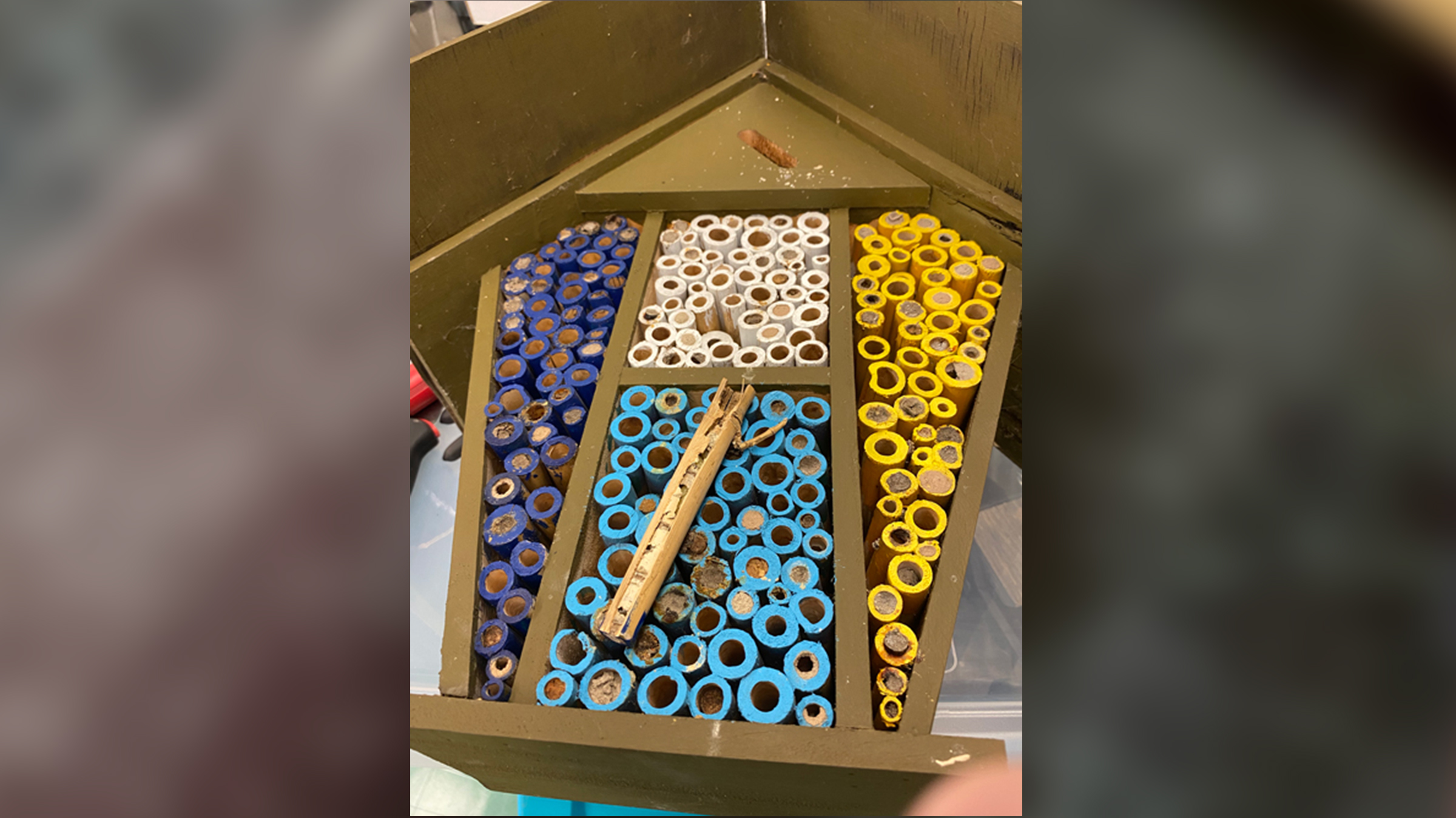
Common images of bees often show them living in a hive or colony. These are European honeybees and they are considered “social” bees. While some native bees, such as bumble bees, are social, most are solitary. This means that one solitary female bee makes and provisions her small nest. Most native bees in Texas, such as miner bees, are ground-nesters, but some species, such as mason bees and leaf cutter bees, are cavity-nesters. Many of these docile native bees can be more effective native plant pollinators than introduced honey bees.
There are many ways we can support these solitary bees. This includes eliminating the use of pesticides, planting native plants, and leaving bare ground space and dead trees for nesting. Another popular way some try is to provide a bee “house” or “hotel.” Despite the kind intentions of the house “owner,” this isn’t without possible unintended consequences for the “guests.” In reality, it’s not clear that these help conserve native bees at all, and in some environments are particularly poor at attracting bees.
The reasons bee houses are problematic are plenty. Nick Ivers, graduate student in the lab of Dr. Shalene Jha and a 2021 Stengl-Wyer Fellow, weighs in. “Bee houses aggregate bees allowing them to reach higher than usual nesting densities. Bees and wasps nesting in close proximity are more likely to come into contact with one another and directly transmit gut parasites or mites.”
Common images of bees often show them living in a hive or colony. These are European honeybees and they are considered “social” bees. While some native bees, such as bumble bees, are social, most are solitary. This means that one solitary female bee makes and provisions her small nest. Most native bees in Texas, such as miner bees, are ground-nesters, but some species, such as mason bees and leaf cutter bees, are cavity-nesters. Many of these docile native bees can be more effective native plant pollinators than introduced honey bees.
There are many ways we can support these solitary bees. This includes eliminating the use of pesticides, planting native plants, and leaving bare ground space and dead trees for nesting. Another popular way some try is to provide a bee “house” or “hotel.” Despite the kind intentions of the house “owner,” this isn’t without possible unintended consequences for the “guests.” In reality, it’s not clear that these help conserve native bees at all, and in some environments are particularly poor at attracting bees.
The reasons bee houses are problematic are plenty. Nick Ivers, graduate student in the lab of Dr. Shalene Jha and a 2021 Stengl-Wyer Fellow, weighs in. “Bee houses aggregate bees allowing them to reach higher than usual nesting densities. Bees and wasps nesting in close proximity are more likely to come into contact with one another and directly transmit gut parasites or mites.”

(Left:) Nick Ivers and Laurel Treviño in Shalene Jha's lab. (Right:) Removing mason bee's mud walls that separated pupae chambers.
Some ready-to-purchase homes try to address this by spacing out the nesting tubes in ready-to-purchase bee houses. “The main argument for spreading the nest tubes apart,” Nick says, “is that it makes it harder for parasites and pollen thieves like beetles, ants, and earwigs to make their way from one nest to another. But this does not deter parasitoid bees and wasps that follow bees once they find them.
“Once they’ve located an active nest,” Nick explains, “parasitoids will return to the same nest throughout the season and parasitize each subsequent nest cell as the mother provisions with pollen and lays eggs. If a parasitoid finds a bee hotel, they may find more than one nest, and the entire hotel may experience higher parasitism.”

(Left:) Jennifer Hrobar of Landscaping Services and Nick Ivers. (Right:) bee pupae with frass, chamber dividers, and plugs of compacted leaves.
If these bee houses don’t really serve the intended guest very well, what do they do then? “Bee hotels make for great teaching and learning opportunities,” Nick says. “They can tell an intricate story of complex species interactions--if you know what you're looking at. The real story is about the many ways that insects use the resources we provide to fulfill their needs.”
And just like hotels for humans, bee houses attract a variety of inhabitants building a nest and short-term residents just dodging the elements, including frogs and lizards.
A perfect example of this is in the bee house that had been erected in the UT Pollinator and Orchard Garden. Earlier this year, Nick, Jennifer Hrobar (Landscaping Services), and Laurel Treviño (Outreach Program Coordinator in the lab of Dr. Shalene Jha) inspected and cleaned the bee house.
The cleaning process involved dodging resident spiders, gently splitting bamboo reeds lengthwise to check for larvae or pupae, and removing the frass and debris. The group found a variety of cavity-nesting bees and wasps in various stages of development. After tapping the end of a bamboo reed on the table, a blue orchard/mason bee (Osmia sp.) emerged and they released the fully-developed, mite-covered bee among plant litter outside the building. Several wasps crawled out of their chambers inside the jar where they had placed the split shoots. The immature pupae of leaf-cutter bees and thread-waisted wasps were left in their half-split bamboo chambers or Nick plucked pupae from damaged chambers to place them in test tubes. The test tubes and bamboo reeds were placed in a dark container in the lab, where pupae continued developing.

(Left:) Nick transferring a pupa from a reed to a test tube for continued development (Right:) transferred wasp pupae
One of the nests held a family of male and female bees in perfect condition, making the difficult task of identifying the species much easier. Laurel was able to identify the bees in this family as belonging to a species of the Megachile genus, a species that nonetheless benefited from the resources provided right here on campus.
Thanks to Nick Ivers and Laurel Treviño for their edits.



